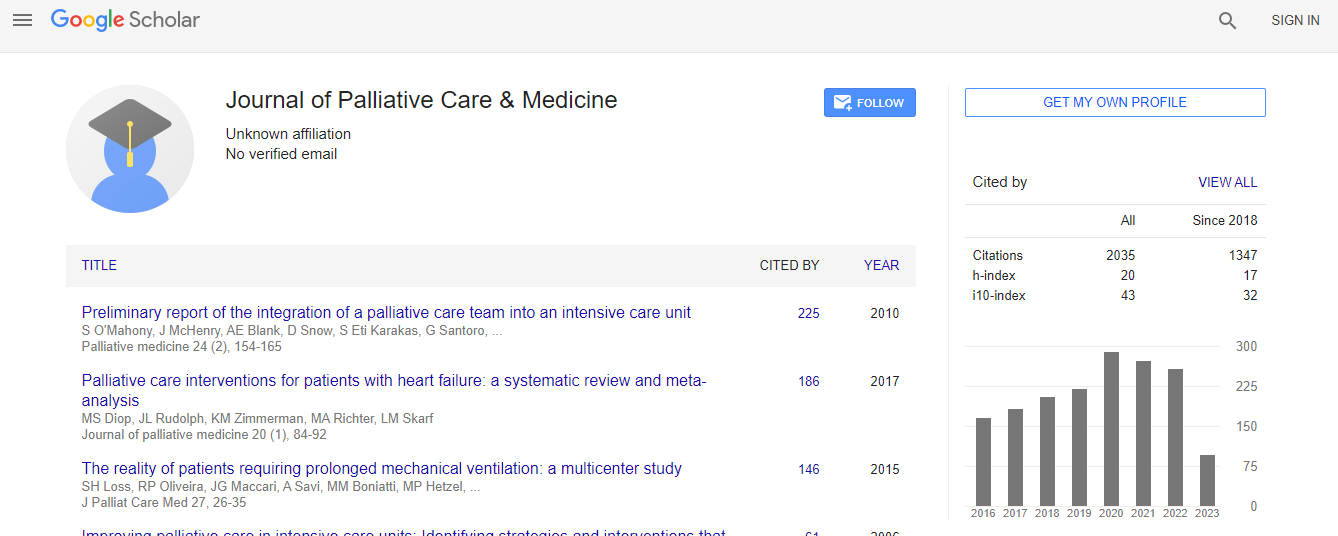Our Group organises 3000+ Global Conferenceseries Events every year across USA, Europe & Asia with support from 1000 more scientific Societies and Publishes 700+ Open Access Journals which contains over 50000 eminent personalities, reputed scientists as editorial board members.
Open Access Journals gaining more Readers and Citations
700 Journals and 15,000,000 Readers Each Journal is getting 25,000+ Readers
Google Scholar citation report
Citations : 1689
Journal of Palliative Care & Medicine received 1689 citations as per Google Scholar report
Journal of Palliative Care & Medicine peer review process verified at publons
Indexed In
- Index Copernicus
- Google Scholar
- Open J Gate
- Genamics JournalSeek
- China National Knowledge Infrastructure (CNKI)
- Electronic Journals Library
- RefSeek
- Hamdard University
- EBSCO A-Z
- OCLC- WorldCat
- Virtual Library of Biology (vifabio)
- Publons
- Geneva Foundation for Medical Education and Research
- Euro Pub
- ICMJE
Useful Links
Recommended Journals
Related Subjects
Share This Page
Preliminary analysis: Nursing turnover rates, nursing students, self-efficacy, continuous selfimprovement, and coping skills
4th International Conference on Palliative Care, Medicine and Hospice Nursing
Dale M Hilty
Mount Carmel College of Nursing, USA
Posters & Accepted Abstracts: J Palliat Care Med
Abstract
Halter and colleagues (2017) reviewed primary research articles using the Nursing Turnover Cost Calculation Methodology and found the turnover rate was 27% (Duffield et al, 2014) in the United States. Halter and colleagues (2017) summarized Li and Jones' (2013, p. ) Findings: "This review was based on ten studies, eight of which were in acute hospital settings, all conducted in the USA, with one also in each of Australasia and Canada. The review reported costs of per nurse turnover ranging from $10,098 to $88,000…” The purpose of this educational intervention was to determine whether high and moderate-low scores on selfefficacy differentiated coping skills with a sample of nursing students. Instrumentation: Self-Efficacy (Schwarzer & Jerusaslem, 1995), Wooden's Competitive Greatness (Hilty, 2017) construct (i.e., being the best you can be when your best is needed, continuous self-improvement, appreciating difficult challenges), and Greenglass' et al. (1999) proactive coping, reflective coping, and strategic planning. If nursing students reported different levels of continuous self-improvement and coping skills in relation to self-efficacy, it may be possible to track these students following graduation to determine the relationship between turnover rates and these research constructs. A sample of Bachelor of Science in Nursing (BSN) traditional students were divided into two groups using the self-efficacy scales. Hypothesis 1: There would be a difference between self-efficacy (high and moderate-low scoring groups) when compared to the Proactive Coping, Reflective Coping, Strategic Planning scales (SPSS 25, Independent t-test). Hypothesis 2: A difference would be found using self-efficacy as the dependent variable and competitive greatness (i.e., continuous self-improvement) as the predictor variable (SPSS 25, linear regression). Independent t-test (N=61) analyses found significant differences between Proactive Coping (p=.001 ), Reflective Coping (p=.001), and Strategic Planning (p=.001) scales. The linear regression analysis confirmed the hypothesis 2 prediction and produced a correlation between self-efficacy and competitive greatness of .515 (r square = .265) which is significant (F (1, 59)=21.307, p=.001). Higher levels of self-efficacy are associated with higher levels of continuous self-improvement.Biography
Dale M Hilty, Associate Professor, received his PhD in counseling psychology from Department of Psychology at the Ohio State University. He has published studies in the areas of psychology, sociology, and religion. Between April 2017 and April 2018, his ten research teams published 55 posters at local, state, regional, national, and international nursing conferences.
E-mail: dhilty@mccn.edu

 Spanish
Spanish  Chinese
Chinese  Russian
Russian  German
German  French
French  Japanese
Japanese  Portuguese
Portuguese  Hindi
Hindi 
